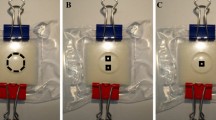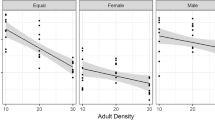Summary
Crowding effects of larvae on survival and development were examined for the broad-horned flour beetle,Gnathocerus cornutus (F.). The larvae matured about 3 weeks after hatching regardless of their densities, but pupation was severely hindered by crowding. There existed an upper limit for the number of the pupae produced and its mechanism was studied by a statistical analysis of the distribution patterns of pupal cells and the experiment in which glass tubes were artificially supplied in addition as pupation site. These studies show thatG. cornutus larvae have a habit to construct cells for pupation and this habit leads to a contest competition for pupation site at high densities. The significance of the contest competition for population regulation was discussed comparing the results onTribolium confusum Jacqueline duVal.
Similar content being viewed by others
References
Charlesworth, B. (1972) Selection in populations with overlapping generations. III Conditions for genetic equilibrium.Theor. Popul. Biol. 3: 377–395.
Hassell, M. P. (1975) Density dependence in single-species populations.J. Anim. Ecol. 44: 283–295.
King, C. E. andP. S. Dawson (1972) Population biology and the Tribolium model. In Th.Dobzhansky, M. K. Hecht andW. C. Steere (eds)Evolutionary biology, Vol. 5. Appleton-Century-Crofts, New York.
Park, T., E. V. Gregg andC. Z. Lutherman (1941) Studies in population physiology X. Interspecific competition in populations of granary beetles.Physiol. Zool. 14: 395–430.
Park, T., D. B. Mertz, W. Grodzinski andT. Prus (1965) Cannibalistic predation in populations of flour beetles.Physiol. Zool. 38: 289–321.
Sokoloff, A. (1974).The biology of Tribolium, with special emphasis on genetic aspects, Vol. 2. Clarendon Press, Oxford.
Takahashi, F. (1972) The stage structure in the population ofTribolium confusum Duval with reference to its equilibrium density.Kontyû 40: 194–202.
Takahashi, F. andY. Yamamoto (1972) Upper limit of the population growth ofTribolium confusum Duval.Kontyû 40: 55–64.
Tsuda, Y. andT. Yoshida (1984) Population biology of the broad-horned flour beetle,Gnathocerus cornutus (F.), (Coleoptera, Tenebrionidae) I. Life table and population parameters.Appl. Ent. Zool. 19: 129–131.
Young, A. M. (1970) Predation and abundance in populations of flour beetles.Ecology 51: 602–619.
Author information
Authors and Affiliations
Rights and permissions
About this article
Cite this article
Tsuda, Y., Yoshida, T. Population biology of the broad-horned flour beetle,Gnathocerus cornutus (F.) II. Crowding effects of larvae on their survival and development. Res Popul Ecol 27, 77–85 (1985). https://doi.org/10.1007/BF02515481
Issue Date:
DOI: https://doi.org/10.1007/BF02515481




